Search our Archives:
» Home
» History
» Holidays
» Humor
» Places
» Thought
» Opinion & Society
» Writings
» Customs
» Misc.
|
Goebbels, Culture and Propaganda
By Peter Bjel
Joseph Goebbels was the first to see the potential
of fusing art, culture and the Nazi state. Hitler so wished this
merging, and so came to pass the transmission of Nazi ideology
through art and culture. This is the second of three articles.
Given his
own intellectual and academic background, cultural and artistic
things intrigued the Third Reich’s Propaganda Minister, Joseph
Goebbels. It was almost certainly by this that he seized on the
dissemination-potential that cultural outlets could serve in
propagating Nazi ideology – but also on the potency of culture
in fomenting dissent. “Goebbels was an impresario of genius,
the first man to realize the full potentialities of mass media for
political purposes in a dynamic totalitarian state.”1
Not everyone within the Nazi hierarchy agreed with the prospect of
fusing art, culture and the Nazi state together, notably Alfred
Rosenberg, with whom Goebbels would have a lengthy rivalry that would
emerge between and within their respective ministries.
Goebbels
won out, in the end, because Hitler so wished this convergence. “Yet
this was exactly what Hitler wanted: a fusion of politics,
propaganda, and art. He considered politics to be the greatest of
all arts, and propaganda the most important arm of politics. And
Goebbels was in full agreement with Hitler…”2
At the end
of November 1933, a Reich Chamber of Culture was unleashed, and
Goebbels allied himself with Robert Ley, who had been the Nazi
Economics Minister, in creating an organization known as ‘Strength
through Joy,’ which served to undermine the likes of
Rosenberg’s cultural opinions while channelling and branching
out more power to Goebbels. With so much power centred on Goebbels,
there were reasons for satisfaction. “With this power, he could
‘mobilize the spirit’ in the people for Hitler’s
policy of foreign expansion.”3
Once war broke out in September 1939, these cultural conduits would
be contoured to fit the ideological and circumstantial needs of the
time. By way of cultural spheres, Nazi influence was all
encompassing, covering film and theatre, literature, visual art and
the presses, as well as radio programming and music. These spheres
shall all be considered in turn.
* * *
On film
(and, perhaps, to a lesser extent, the theatre), Goebbels advised
against making any overtly propagandistic feature, out of concern
that its abruptness would simply turn people away, closed-minded.
“More than all other forms of art, the film must be popular in
the best sense of the word,” he declared. “Nor must it
lose its strong inner connection with the people. Films should be
strictly contemporary in spirit even when dealing with subjects set
in the past; once they achieve this quality they will bridge the
nations and become the ‘spokesmen for our age.’”4
To achieve this, Goebbels stood poised to provide state-backed
incentives and capacities for filmmakers to hold a degree of creative
independence.
A few
films were concerned with overtly propagandist themes, though
Goebbels took care to not carry this on excessively; all of these
things notwithstanding, the German film industry under Hitler and
Goebbels wound up suffering from a creative ‘brain-drain,’
whereby many of the country’s most talented filmmakers and
directors – Fritz Lang is a great example – were forced
into temporary or permanent exile abroad.5
Akin to one of his propaganda principles, Goebbels spent much time
observing foreign-made films, even after 1939. American films he was
especially keen on studying, and he went to great lengths to acquire
copies of them. “The press attaches in German embassies in
Sweden, Switzerland and Portugal were under orders to get hold of
prints of American films and have them illicitly copied for him.”6
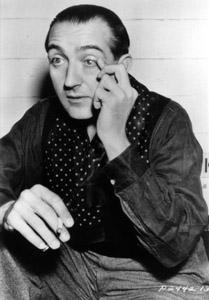
Under Hitler and Goebbels, many of
Germany’s most talented filmmakers, like Fritz
Lang, were forced into temporary or permanent exile
abroad.
Reflecting
on the subtlety that was the working rule for most Nazi-era films,
Eric Rentschler writes that the Third Reich’s film industry was
a product of “more than anything, a Ministry of Illusion,”
and that “The customary tropes of the uncanny and horrendous do
not accurately characterize the vast majority of the epoch’s
films, light and frothy entertainments set in urbane surroundings and
cozy circles, places where one never sees a swastika or hears a ‘Sieg
Heil.’”7
Yet there remained a sinister motive behind film, and it was that
“Goebbels endeavoured to maximize film’s seductive
potential, to cloak Party priorities in alluring cinematic shapes, to
aestheticize politics in order to anaesthetize the populace,”
and “German films were to become a crucial means of dominating
people from within, a vehicle to occupy psychic space, a medium of
emotional remote control.”8
By
Rentschler’s count, 86 percent of films churned out during the
Nazi era were of the so-called “unpolitical” variety,
which extolled the banal features of life without signs of the Third
Reich.9
The German revue film, which “shows the civilian troops on
parade, often garbed in uniforms and usually choreographed as a
costumed cadence march,” with its mechanized columns of bodies,
often scantily-clad, had “psychic emotion” prevalent.10
Leni Riefenstahl’s Triumph des Willens, released in
1935, and probably one of the most famous films to come out of the
Nazi era, falls into this category. “The masses are allowed to
enter the picture, but only their leaders are allowed to speak.
Hitler himself is the main actor, here celebrating his wedding
fantasies with the masses.”11
It too bears such subtleties, as when it opens with shots from the
high skies, amid clouds, out of which it becomes clear that, from
these ‘high heavens,’ Hitler is descending to Earth (in
his airplane) and to a nation waiting for him with perfect adulation,
as if he were a god.12
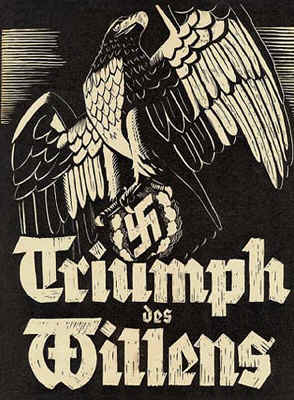
Triumph of the Will is probably one of the most famous films to come out of the Nazi era.
The
remaining fourteen percent of films, however, were the exact
opposite; the ways in which they were drawn on real-life and set
ideological themes demonstrated Goebbels’ system of mythmaking
at work. Thus, Hitlerjugend Quex, directed by Hans Steinhoff
and set in the chaotic Weimar period, drew on the murder and
subsequent martyrdom of a certain fifteen year-old Herbert Norkus
who, in January 1932, was stabbed to death by Communists in revenge
for the death of one of their own. Norkus had been out distributing
Nazi pamphlets in a working-class district of Moabit.13
Goebbels
went on a harangue in Der Angriff, detailing the wickedness of
Communist “child-murderers” and the death of Norkus: “The
delicate head is trampled to a bloody pulp. Long, deep wounds go
into the slender body, and a mortal gash penetrates heart and
lungs….Wearily, black night descends. From two glassy eyes
stares the emptiness of death.”14
According
to Jay W. Baird, “The life and death of Herbert Norkus had lent
new credence to the ethos of the Hitler Youth.”15
A novel by Karl Aloys Schenziner, and then a film soon followed his
elaborate state funeral, and Norkus became the character Heini
Voelcker: “It was at once a propaganda and aesthetic success,
an ornament to Goebbels’ dream of utilizing the best of modern
technique in the service of the mythical National Socialist ideal.
Above all, it appealed to youth in a remarkable way. Through both
Party and Ufa [the official Nazi film distribution company]
commercial channels, its audience numbered well over 20,000,000
viewers….As late as 1942 it was being shown in the
Jugendfilmstunden of the Hitler Youth, an important propaganda
activity of the organization.”16
So it was,
in this example, that film, myth, and history were put together and
moulded into one type of Nazi-era film that emanated from Goebbels’
ministry.17

Herbert Norkus (above) and his death in January 1932
was propagated by Goebbels, and became the premise for the film
Hitlerjugend Quex.
When war
broke out in September 1939, the Nazi film ministry began to produce
films that sometimes reflected and ideologically shaded this reality
via films. Thus, for example, the film Ohm Krueger, though it
was set in South Africa during the Boer War, meshed this past setting
with the present war with Britain. The dying and defeated character
Krueger declares that, “Thus England subdued our small nation
by the cruelest means. But the day of judgement will come at last.
I don’t know when, but so much blood cannot have been spilled
in vain. So many tears will not have been shed for nothing. We were
a small and weak nation. But big and powerful nations will stand up
to British tyranny. They will strike against England’s soil.
God will be with them. And then the path will be free for a better
world.”18
The film,
at one point, according to Marcia Klotz, subtly demonizes the British
for having placed Boers in concentration camps, which they had
(indeed) been the first to invent – though it is not, of
course, pointed out that the Germans had quite clearly outdone the
British in this regard at the time Ohm Krueger was released.
Klotz quotes David Hull: “The unbelievable gall of blaming the
invention of concentration camps on the British – whether true
or not – showed Goebbels at the height of his cynicism.”19
In light
of concentration camps, as well as the system at work behind them,
Hitler conducted two parallel wars at the same time: one against what
would become the Allies, and the other on the Jews of Europe, the war
on the latter of which he intensified when he began losing the
former.20
Though evidence of the “Final Solution to the Jewish Question”
never made its way into popular films sanctioned by Goebbels’
ministries, the vicious anti-Semitism which began the evolution of
Nazi-Jewish policy in such a direction, and which was a staple of
Nazi ideology, did come out. Two of the most infamous films in this
regard were both released in 1940: Franz Hippler’s Der Ewige
Jude, and Veit Harlan’s Jud Suess.
The
former, the title of which means “The Eternal Jew,”
included not-so-subtle depictions of Jews as rats scurrying from a
sewer-grating and infesting all surroundings. At one point, the film
centres on a group of (degenerate-looking) Hasidic Jews, apparently
meant to collectively represent East European Jews as they ‘normally’
are, but then fades to this same group without their beards and
discernible clothes. “The hair, beard, skullcap and kaftan
make the Eastern Jew recognizable to everyone,” the narrator
warns. “Should he remove them, only sharp-eyed people can spot
his racial origins. An essential characteristic of the Jew is that
he always tries to hide his origins when among non-Jews.”21
A similar
cinematic technique is employed in Harlan’s Jud Suess, where
the film’s antagonist Suess-Oppenheimer is introduced in such
appearance, and is last seen at his execution the same way. During
the rest of the film, however, he appears the way the rest of the
German villagers are dressed, further lending credence to the
depictions of his deceit and cunning deviousness.22
The story revolves around the character of Suess-Oppenheimer coming
to the German village of Wuerttemberg, whereby he loans a lot of
money to Duke Karl Alexander; the entire village is in pandemonium
when the Duke, who cannot repay Suess-Oppenheimer, allows other Jews
to move in. A sub-plot also ensues, whereby Suess-Oppenheimer winds
up making advances on the Duke’s daughter, Dorothea and,
supposedly alluding to vampire-like connotations, rapes her while her
husband is being tortured.23
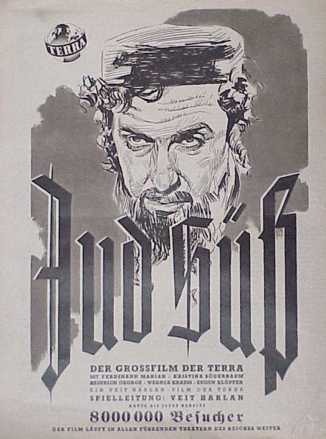
A poster for Veit Harlan’s 1940 film Jew
Suess.
Goebbels’
objective with Harlan’s film was at least partially successful;
more than 20 million viewers saw it, and “It was often screened
in areas where deportations of Jews to concentration camps were
planned, and was shown to SS soldiers before they were ordered to
move against Jews. According to some reports, theatre-goers often
attacked Jews in the streets after viewing the film.”24
According to David Stewart Hull, the other, substantially polished
anti-Semitic film churned out by Goebbels’ ministry was Die
Rothschilds Aktien auf Waterloo, which also came out in 1940; he
described it as “one of the most viciously polished pieces of
propaganda-fiction of the Nazi period.”25
Other
films, as with literature and any other nonstandard manifestations of
culture, were purged or, in some cases, pushed underground. Even as
early as 5 December 1930, this happened when the film adaptation of
Erich Maria Remarque’s 1929 anti-war novel Im Westen nichts
Neues (that is, All Quiet on the Western Front) was shown
at the Mozart cinema. Goebbels subverted it by buying a block of
tickets and distributed them to SA men, whereupon they released mice
and stink bombs in the theatre itself in which it was screened. Six
days later, the Weimar chief film censor banned the film, to which
Goebbels commented: “The film of shame has been banned. With
that action the National Socialist movement has won its fight against
the dirty machinations of the Jews all along the line.”26
Remarque was, in fact, Roman Catholic, but his book, as well
as its sequel Der Weg Zuruck (that is, The Road Back),
published in 1931, was among the many examples of pacifistic
‘un-German’ literature that was incinerated during the
book burnings.27
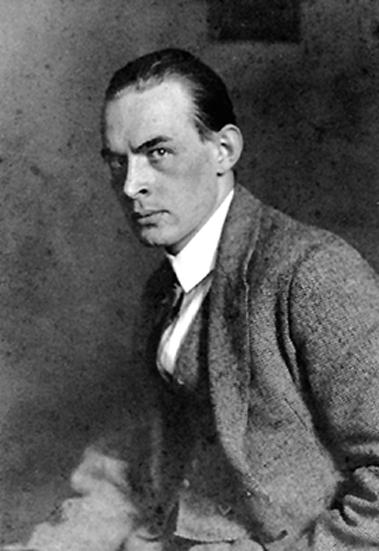
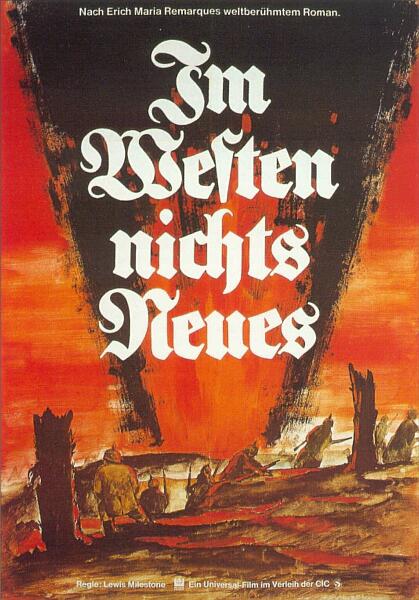
Erich Maria Remarque (photo) and his famous 1929
book All Quiet on the Western Front which was made into a film (poster) one
year later, were all attacked by the Nazis.
The
German theatre bore a similar fate of forced ideological
Nazification, as when Max Reinhardt’s Deutsches Theater Berlin
was gradually incorporated into the Reich Theatre Chamber, another
offshoot of the Cultural Ministry, and became an outlet for the
types of theatrical performances Goebbels permitted. “During
the fourteen months that had elapsed since the exile of Max
Reinhardt, the theatre had lost not only its owner, but also its
repertoire, its regular audience, and many members of its famed
ensemble.”28
In 1935,
after the death of Theatre Chamber President Otto Laubinger,
Goebbels succeeded in reining in the theatres to his Ministry, first
by purging its officials of Jews and (alleged) Communists, then by
setting out ideologically fit productions to be performed, and
instituting rigorous personnel filtration schemes, such as entrance
examinations and background checks for those wishing to become
involved in the theatre.29
Goebbels’ tactics on the theatres were successful in large
part because of theatre personnel: “It was their own
susceptibility to various forms of seduction that allowed German
theatre people to play an important supporting role in the Third
Reich,” especially through the “multifaceted patronage
of the theatre establishment.”30
In the
fields of visual art, literature and the press, the same techniques
of creativity interspersed with ideological enforcement were
undertaken. Visual artists, like their filmmaker counterparts, were
forced to flee abroad or cease their activities, while the industry
and the art itself that had been crafted pre-1933 underwent purges.
“The purge of modern art was not, however, limited to the art
produced by Jewish, foreign, or Communist artists. Whatever the
Nazis claimed undermined ‘desirable’ aesthetic, social,
cultural, or political values, or physical or racial ideals, was to
be eliminated from German society; this included all the modern
movements, such as Expressionism, Cubism, Futurism, Constructivism,
and Dada.”31
Hitler’s
pronouncements on permissible and impermissible art effectively
decimated this creativity in Germany. It can also be read as a
microcosm of fascism itself. “Firmly believing that culture
is the cornerstone of any enduring society, Hitler recognized that
art must play a major role in the building of his ideal German
nation. He articulated the goals of what he considered true German
art: it must develop from the collective soul of the people and
express its identity; it must be national, not international; it
must be comprehensive to the people; it must not be a passing fad,
but strive to be eternal; it must be positive, not critical of
society; it must be elevating, and represent the good, the
beautiful, and the healthy.”32
Literature
and literary control was one of the few fields in which Goebbels’
rival, Rosenberg, won out over jurisdiction and authority via the
‘Amt Shrifttumspflege,’ an office endowed with the
mandate to, once again, propagate National Socialism. “The
Amt’s activities were, therefore, focused on three
objectives: the evaluation of current German literature, the
promotion of these books found to be ideologically compatible with
National Socialist doctrines, and the control and supervision of
literature with the Party at the Gau and Kreis levels.”33
Akin to
what was happening elsewhere in cultural matters under Nazi control
and supervision, the obvious quality and output declined
drastically, as Herbert P. Rothfeder points out: “Books which
received positive evaluations were generally those which correctly
extolled National Socialist doctrine, glorified Germanic virtue, or
demonstrated the inherent superiority of the Nordic race over the
remainder of Europe. Technical and scholarly works [!] were judged
primarily on their proper interpretation of National Socialist
ideology rather than on their factual content.”34
A system of literary façade joined the ranks of Nazi
culture, whereby one German evaluator of literature quipped, “The
typical Nazi author always tried to cover up his lack of ideas…by
a spate of words which sounded impressive and meant nothing.”35
Rothfeder
notes, revealingly, that out of fear of provoking a powerful
institution as the Roman Catholic Church (the influence of which
still resonated widely among the German population), this was the
only zone in which literary control and censorship had “absolutely
no effect.” Banned books written by taboo authors as Heinrich
Heine, Theodor Herzl, Emil Ludwig and Karl Marx, could still be
found and read in Nazi Germany.36
This was
a fate that befell the Nazi campaign against jazz music. Its fault
was because it “quintessentially represented the principle of
improvisation, equalling musical freedom,” the music’s
“originators and disseminators…were degenerate blacks
and Jews, and, to a lesser extent and in Europe, libidinous
Gypsies.” The “syncopated rhythm of jazz” was not
conducive to militarism and the easy transmission of propaganda
messages, and finally, jazz was “so individualistic as to be
trivial, compared to the racial-communal, lofty objectives of the
Nazi rulers.”37
The demand for jazz, remarkably, never waned, and radio, long held
by Goebbels to be a revolutionary means of further disseminating his
messages (as when he declared, “We make no bones about it: the
radio belongs to us, to no one else! And we will place the radio at
the service of our idea, and no other idea shall be expressed
through it!”) was, until early 1943, forced to play jazz on
the air for the sake of cheering up the returning frontline
soldiers, for “the needs of the combat troops always came
first.”38
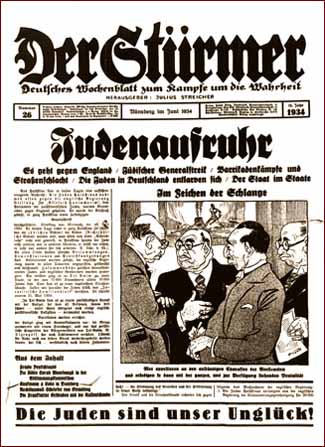
A page from the paper Der
Stuermer. Note the solely
anti-Jewish tone of it. According to Cedric Larson, Goebbels
believed that the “press of Germany should be a piano upon
which the government might play.”
Similarly,
the press, several of which had been important organs and outlets
for Nazi propaganda and promotion during the so-called Kampfzeit
(the “time of struggle,” which is how the Nazis
called the period prior to their power seizure), were
incorporated into the State concept of Gleichshaltung, “which
is, so to say, the foundation-stone of policy of the Third Reich,
and calls for the complete coordination and harmonizing of all
internal and external national activity.”39
Cedric Larson, writing in 1937, reported, “Upon the subject
of press control, Dr. Goebbels declared that he did not see in
censorship either a normal or ideal condition. The press should aid
the government and not criticize in such manner as would shake the
faith of the people in the government. The mission of the press
should be not merely to inform, but also to instruct. The press of
Germany should be a piano upon which the government might play.”40
* * *
Viktor
Reimann, one of Goebbels’ biographers, writes that this attack
on the press, and even on independent thought, came from the fears
of Hitler himself. “He saw in it [the press] essentially a
product of liberalism and the individualist concept –
sufficient reason to despise it from the bottom of his heart. A
press without freedom of opinion was bound to be a caricature. But
freedom of opinion was something Hitler feared and rejected.”41
Goebbels, at this stage, did Hitler’s bidding and swallowed
it up into his Ministry, which then went about creatively and subtly
disseminating the Nazi ethos via these many cultural routes.
Eric
Rentschler concludes his analysis of the German cinema thusly: “If
the Nazis were movie-mad, then the Third Reich was movie-made, a
fantasy order that in equal measure was dream machine and a death
factory.”42
He could easily have been talking about all cultural endeavours and
fields that fell afoul of Goebbels’ obsession with subtlety
and the transmission of Third Reich ideology.
* * * * *
Peter Bjel is a freelance writer and teacher candidate, and holds
degrees in Politics and History from the University of Toronto. He
can be reached at peterbjel@hotmail.com.
This is the second of three articles about Goebbels,
propaganda and the Third Reich.
NOTES:
1
H. R. Trevor-Roper, “Hitler’s Impresario,” New
York Review of Books 25, 9 (1 June 1978), HTML.
2
Viktor Reimann, Goebbels: The Man Who Created Hitler (Garden
City, NY: Doubleday, 1976), p. 166.
3
Ralf Georg Reuth, Goebbels: A Biography (New York: Harcourt
Brace & Company, 1993), p. 192. For the Reich Chamber of
Culture’s formation, see pp. 191-192. Additionally, on the
structure of the Propaganda Ministry and the satellite Chamber of
Culture, see pp. 135-137.
4
Quoted in Roger Manvell and Heinrich Fraenkel, Dr. Goebbels: His
Life and Death (New York: Simon and Schuster, 1960), p.
140.
5
Ibid., p. 141; the point about Lang is my own. This is also the
conclusion of David Stewart Hull, “Forbidden Fruit: The
Harvest of the German Cinema, 1939-1945.” Film Quarterly
14, 4 (Summer 1961): pp. 16-30, at p. 30, who argues that this
problematic legacy carried on into the post-war period.
6
Manvell and Fraenkel, Dr. Goebbels, p. 228.
7
Eric Rentschler, “Ministry of Illusion: German Film,
1933-1945.” Film Comment 30, 6 (November 1994): pp.
34-42, at p. 36.
10
Karsten Witte, “Visual Pleasure Inhibited: Aspects of the
German Revue Film.” New German Critique 24/25 (Autumn
1981/Winter 1982): pp. 238-263, at pp. 238, 243.
12
For a further discussion of Triumph des Willens, see David B.
Hinton, “’Triumph of the Will’: Document or
Artifice?” Cinema Journal 15, 1 (Autumn 1975): pp.
48-57. The opening scene descriptions are from my own observations
and take of the film.
13
Reuth, Goebbels, p. 141.
14
Quoted in Ibid. For a long excerpt from this portion of Der
Angriff, see Jay W. Baird, “From Berlin to Neubabelsberg:
Nazi Film Propaganda and Hitler Youth Quex.” Journal of
Contemporary History 18, 3 (July 1983): pp. 495-515, at p. 500.
15
Baird, “From Berlin to Neubabelsberg,” p. 501.
17
Ibid., p. 495 (for the three points).
18
Quoted in Marcia Klotz, “Epistemological Ambiguity and the
Fascist Text: Jew Suess, Carl Peters, and Ohm Krueger.”
New German Critique 74 (Spring/Summer 1998): pp. 91-124, at
p. 112.
19
Quoted in Ibid., p. 120.
21
As quoted in Klotz, “Epistemological Ambiguity and the Fascist
Text,” p. 119, n. 47. The rest of the descriptions are from
my own observations and take of the film.
22
From my own observations and take of the film.
23
Hull, “Forbidden Fruit,” pp. 19-20, for the story; and
from my own observations and take of the film. On the point about
vampirism, see Klotz, “Epistemological Ambiguity and the
Fascist Text,” pp. 100, 122. The film concludes with the
ominous and cryptic warning: “May the citizens of other states
never forget this lesson.”
24
Klotz, “Epistemological Ambiguity and the Fascist Text,”
p. 97. On Goebbels and these anti-Semitic films, see Reuth,
Goebbels, pp. 261-262, 277-278.
25
Hull, “Forbidden Fruit,” p. 28.
26
Quoted in Reimann, Goebbels, p. 127. The whole episode with
Remarque’s film is described in pp. 126-127; and in William G.
Chrystal, “Nazi Party Election Films, 1927-1938.” Cinema
Journal 15, 1 (Autumn 1975): pp. 29-47, at p. 34.
27
Remarque’s biographer pays much attention to Remarque’s
clashes with the Nazis, and the subsequent banning of his books.
See Hilton Tims, Erich Maria Remarque: The Last Romantic (New
York: Carroll & Graf Publishers, 2003). Tims argues that
post-1945 Germany was painfully (and disgracefully) slow to
reinstate Remarque as part of the country’s literary and
cultural canon. That process is still underway.
28
Wayne Kvam, “The Nazification of Max Reinhardt’s
Deutsches Theater Berlin.” Theatre Journal 40, 3
(October 1988): pp. 357-374, at p. 373.
29
See Alan E. Steinweis, “The Professional, Social, and Economic
Dimensions of Nazi Cultural Policy: The Case of the Reich Theatre
Chamber.” German Studies Review 13, 3 (October 1990):
pp. 441-459, at pp. 444, 447-448.
31
Mary-Margaret Goggin, “’Decent’ vs. ‘Degenerate’
Art: The National Socialist Case.” Art Journal 50, 4
(Winter 1991): pp. 84-92, at p. 86. See p. 89 of her article, on
the fates of the many German artists that had to flee the country
amid the artistic purges.
33
Herbert P. Rothfeder, “’Amt Schrifttumspflege’: A
Study in Literary Control.” German Studies Review 4, 1
(February 1981): pp. 63-78, at p. 65.
35
Quoted in Ibid., p. 72.
36
Ibid., pp. 76-77, for details on this exception. Gerwin Strobl,
“The Bard of Eugenics: Shakespeare and Racial Activism in the
Third Reich.” Journal of Contemporary History 34, 3
(July 1999): pp. 323-336, is a fascinating and shocking piece about
the ways in which Nazi racial ideology was seeped into the German
Shakespeare Society, thereby granting a degree of historical and
artistic legitimacy and prestige to Nazi racial ideas. There can be
no finer example of the corrupting effects Nazi cultural policies
had on all facets of culture in Germany – and beyond.
37
For these four points, see Michael H. Kater, “Forbidden Fruit?
Jazz in the Third Reich.” The American Historical Review
94, 1 (February 1989): pp. 11-43, at p. 13.
38
Ibid., p. 30. The earlier quote by Goebbels on radio is quoted in
Craig, “The True Believer.”
39
Cedric Larson, “The German Press Chamber.” The
Public Opinion Quarterly 1, 4 (October
1937): pp. 53-70, at p. 56.
40
Ibid., p. 57. A fascinating article, based almost exclusively on
the Reich press decree of 4 October 1933 and Nazi Party organs, like
the Voelkischer Beobachter, written on the eve of war.
41
Reimann, Goebbels, p. 206.
42
Rentschler, “Ministry of Illusion,” p. 42.
~~~~~~~
from the November 2011 Edition of the Jewish Magazine
|
|
Please let us know if you see something unsavory on the Google Ads and we will have them removed. Email us with the offensive URL (www.something.com)
|





|
